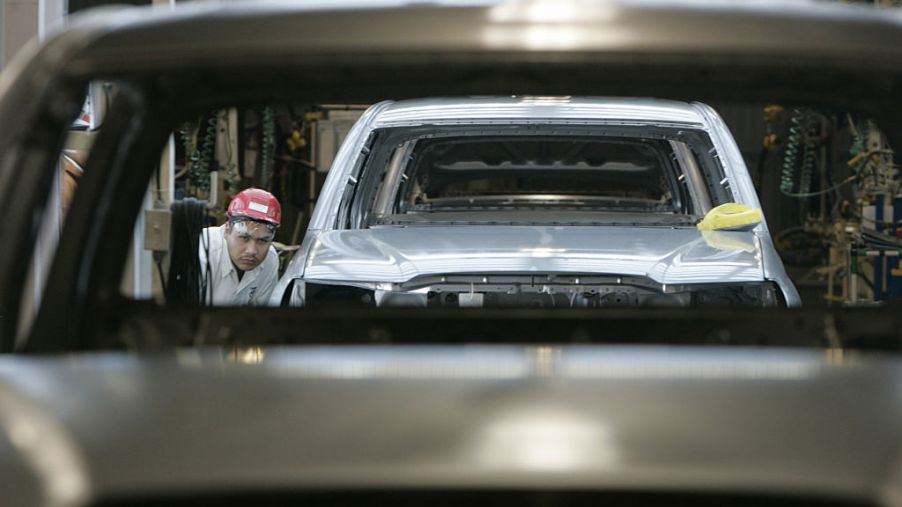
Toyota Doesn’t Think This Truck Trend Will End Anytime Soon
Toyota makes the U.S.’s best-selling mid-size pickup truck, the Tacoma, and best-selling SUV, the RAV4. Trucks.com talked with Bill Fay, who is the senior vice president of automotive operations at Toyota North America, about the company’s popular vehicles, the future for trucks, and other innovations at Toyota. Here are the highlights of what Fay shared.
Trucks and SUVs will become even more popular
Trucks.com pointed out that pickup trucks, SUVs, and crossovers are already 70% of the U.S. market. Fay expects that number to increase slightly more, possibly to around 75%, but he doesn’t expect it to rise higher than that. He thinks passenger cars will remain around 25% of the market.
This belief reflects Toyota’s focus on trucks and SUVs that Automotive News reported on early in 2019. In 2018, Toyota saw an 8.9% increase in its light truck sales, generating 62% of overall sales.
Leading the pack were RAV4, Tacoma, Highlander, 4Runner, and Tundra, with Tacoma seeing a 24% increase in sales. Toyota then built a third plant to manufacture Tacomas, and began expanding its offerings, variations, and trims for its trucks and SUVs.
Why are car sales on the decline?
The shift to trucks and SUVs has been a trend for a number of years, but it’s worth a look at why. “Since 2009 or 2010 it has been a truck story,” Jeff Schuster, senior vice president of forecasting at LMC Automotive, told CNBC. By 2013, car sales had fallen to 50% of vehicle sales in the U.S. market.
In 2018, Consumer Reports suggested that trucks might be the “new family car.” They pointed to improvements in safety, comfort, and fuel economy as reasons trucks have become more appealing to women and to families. These buyers are also willing to trade bed length for larger cabin space. In addition, luxury trims are appealing to a number of buyers.
Karl Brauer, the executive publisher at Cox Automotive, pointed to lower gas prices, a strong economy, and improvements in SUV design as reasons for the shift away from cars. In 2018, according to Auto Alliance, crossovers were the best-selling segment, followed by pickup trucks and then small cars.
Additional automotive trends
Fay shared Toyota’s view of the future for vehicle design, and it includes more power options and more technology. All these advances should lead to additional trends to look out for in the automotive industry.
More electric vehicles
Toyota plans to have 25% of its vehicles be hybrids or plug-in hybrids by 2025. This includes offering electrified options for each vehicle plus developing dedicated hybrids as well.
This should include electrified options on pickup trucks too, although Fay says, “the details on pickup trucks are still to come.” The hybrid vehicles will target people interested in fuel efficiency.
More tech when it offers value
When asked whether Toyota trucks will feature larger touch screens like in the new Highlander, which has an available 12.3-inch touch screen, Fay says, Toyota is “busy trying to get consumer feedback on what they like in our products and what they would like to see us change.”
Toyota wants to give drivers comfortable access to all the information on the dash, but also needs to make sure the costs of tech upgrades add enough value to the price.
More hydrogen fuel-cell vehicles
The first hydrogen fuel-cell vehicles were sold in California in 2015, and there are still only about 39 refueling stations all in California. These hydrogen-powered electric cars require growth in infrastructure, which Fay says is “going to be gradual like the battery electric vehicle roll out is.”
Toyota is looking at expanding from California into the Northeast next. Toyota already sells a fuel-cell passenger car, the Mirai, in Hawaii and California. Fay also points out that this design is scalable to larger vehicles and shares that Toyota is testing fuel-cell power on tractor-trailers. He says, “We are going to be able to do some things with that in bigger applications that we’re pretty excited about.”
The future of trucks looks strong, and Toyota is counting on the trend to stick around. The company is also investing in technology and innovation for its future vehicles.


